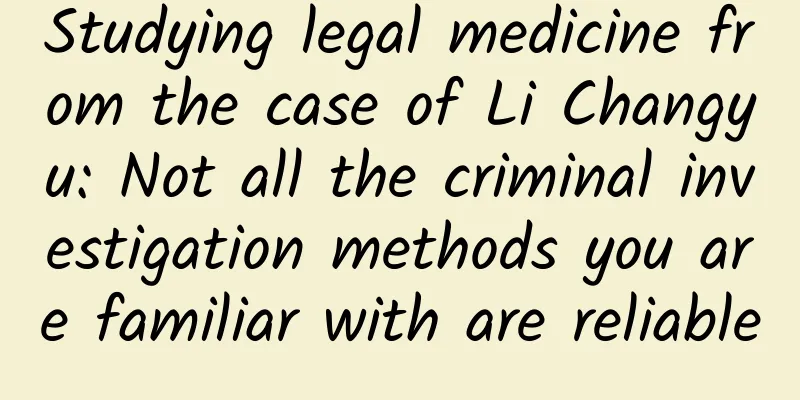Studying legal medicine from the case of Li Changyu: Not all the criminal investigation methods you are familiar with are reliable

|
The case of Chinese "super detective" Li Changyu being charged with perjury has sparked heated discussions around the world. For forensic medicine, an industry that relies heavily on science and technology, it is not necessary for forensic scientists to commit false charges in order to cause wrongful convictions. Technical defects are also enough to cause judges to misjudge. Many of the seemingly reliable criminal investigation methods that we are familiar with through film and television dramas, including fingerprint verification and handwriting verification, actually have huge technical defects. Written by Li Changqing (Doctor of Medicine, practicing physician in the United States) One day in December 1985, Everett Carr, a retired driver in Connecticut, was found murdered in his home. The scene was horrific. It was said that Carr was stabbed more than 20 times, his throat was cut, and his head was hit by a blunt object 7 times. Later, two young men were considered to be the murderers of Carr and were sentenced to more than 50 years in prison each. The two young men had a record of many petty thefts and were considered bad boys, but they both denied that they were involved in the murder. Although the scene was covered with blood, the police did not find any blood on the two suspects. A forensic doctor testified that they detected blood on a towel at the scene, and the suspects may have used this towel to wipe themselves, so there was no blood. The two young men were released on bail in 2018 and 2019 respectively after serving 30 years in prison. Throughout their sentences and after their release, they have never stopped trying to prove their innocence. Their defense lawyers pointed out loopholes in the case investigation process and also provided some new evidence, such as the DNA of the possible murderer found at the scene in 2010 and 2012, which was likely to come from a woman, and the footprints found at the scene were very small and did not match any of the suspects. In 2020, the judge dropped the murder charges against the two. Immediately afterwards, the two filed a new lawsuit, bringing the forensic doctor who was an important witness at the time, eight police officers involved in the case, and the local government to court. This is the case of the Chinese "super detective" Li Changyu being sued for fraud, which was recently reported by the Associated Press and many other media and sparked heated discussions. Li Changyu was the forensic doctor who found the towel evidence, but he was not as famous as he is today. The judge believed that this was a wrongful case and Li Changyu was responsible for it. Li Changyu and his lawyer clearly stated that they would continue to defend themselves, and the final outcome is still unknown. This is not the first case where a forensic doctor has been accused of fraud, and it certainly won’t be the last. In fact, for a profession that relies heavily on science and technology, even if a wrongful conviction is caused, it does not necessarily require the forensic doctor to falsify subjectively. Technical defects can also lead to misjudgments. Forensic science may not be "scientific" On July 28, major media outlets around the world reported the statements of Li Changyu and the local prosecutor. According to Li Changyu's statement, the focus of the issue was mainly on his identification of the towel. Li said that his job was only to "present my scientific findings in court, and it is the responsibility of lawyers and judges to determine which evidence to use and what questions to ask witnesses." The chemical test of the blood stains on the towel "has no direct accusatory effect on the two suspects' involvement in the case." He said that he also provided evidence of the suspects' innocence at the time, so even if it was finally determined to be a wrongful conviction, he should not be held responsible. Li testified in court that the stain on the towel was blood, based on the fact that he tested the towel for tetramethylbenzidine at the scene, and the result was positive. The tetramethylbenzidine test is a blood screening technology that reacts with catalase in the blood to produce a color change. The tetramethylbenzidine test was developed in the 1970s as an alternative to the carcinogenic benzidine test. Due to its high sensitivity, it is still a common technology for blood testing screening. However, catalase is also present in some vegetables and animal blood, so further identification is needed to confirm that the results are from human blood (confirmatory testing). But this is not the main problem. The biggest flaw of tetramethylbenzidine detection is the damage to DNA. In 1985, Li Changyu used this method to test blood, which was standard practice. The biggest failure in this case was that the police did not conduct routine definitive testing when the towel was collected. DNA identification technology was first used in 1986, and large-scale application was not until the mid-1990s. Even if DNA identification technology was available at the time, it is very likely that no DNA could be detected in this towel, because, as mentioned above, tetramethylbenzidine testing will destroy DNA. In the field of forensic medicine, it is not just the "blood test" that has fatal flaws. With the development of science, more and more "classic" criminal investigation techniques have been found to be not so rigorous. Because of the frequent occurrence of such cases, at the request of the U.S. Congress, the National Research Council (NRC) issued a report on forensic science in 2009, pointing out the following major problems in the field of forensic identification: Lack of scientifically validated technology: Many traditional forensic identification technologies lack scientific validation. Many technologies, such as hair identification and handwriting identification, have been widely used in the past, but have not been fully scientifically studied and validated to determine their reliability and accuracy. Experts’ subjective tendencies and biases: Expert opinions in forensic identification may be influenced by subjective judgment and personal bias. This may lead to different experts reaching different conclusions on the same evidence, resulting in inconsistent court decisions. Insufficient cross-disciplinary collaboration: Forensic identification often involves knowledge from multiple disciplines, such as biology, chemistry, physics, etc. However, insufficient communication and collaboration between different disciplines may affect the accuracy and reliability of comprehensive identification. Inadequate training and lack of standards: Some forensic scientists have inadequate training and education, and lack necessary professional standards and codes of practice. This can lead to irregularities and incorrect application of techniques. Presentation of evidence: The report highlights the problem of presentation of forensic evidence in court, where experts’ statements may be too affirmative or too vague, making it difficult for judges and juries to understand and assess the reliability of the evidence. Analysis of several major criminal investigation techniques In the field of forensic medicine, the objective limitations of technology and the subjective bias and even fraud of practitioners often combine with each other (the former gives space to the latter), jointly resulting in false convictions. What's more, some criminal investigation technologies have not been subjected to the most basic scientific tests since their inception. The following "problematic" technologies have been or are still regarded as classic criminal investigation methods. FBI Microscopic Hair Analysis: Before 2000, forensic hair analysis at crime scenes relied on microscopic observation. Supporters of the technology claimed that specific hair characteristics were related to physical characteristics such as height. But as doubts about the technology increased and new mitochondrial DNA identification technology was introduced, the Innocence Project, a non-profit organization dedicated to working for wrongly convicted people, began to overturn the cases of people who had been convicted through hair analysis in the past. In the end, the FBI, the U.S. Department of Justice and other organizations jointly reviewed some hair analysis reports before 2000 and found that most of them had errors - 257 of the 268 reports submitted as evidence by the FBI had errors, accounting for 96%. The unreliability of hair microscope analysis lies mainly in the fact that the hair of many people is actually very similar under a microscope, which makes it easy to link unrelated people together and convict people who should be innocent. It is difficult to review how many wrongful convictions have been caused by these unscientific and erroneous forensic reports. Take the United States for example. There were more than 3,000 reports that could be traced back to that year, but as of March 2015, the FBI had only reviewed 500 of them. West's Bite Mark Analysis: Michael West is a dentist in Louisiana, USA, who has provided testimony to the police as a bite mark analysis expert in many criminal cases, including testimony in the trial of the famous serial murderer Ted Bundy. However, as time goes by, more and more bite mark analysis is found to be inaccurate. Including Bundy's case, subsequent research shows that bite mark analysis cannot prove that Bundy left tooth marks on the victims. In 2020, a total of 34 charges were overturned due to the unreliability of tooth mark analysis, including those who had been serving decades in prison or even sentenced to death. For example, Howard, a black man who was arrested in 1992 for murdering a white woman, was sentenced to death because West's testimony proved that the tooth marks on the victim matched his teeth. Fortunately, a DNA test in 2010 proved Howard's innocence. Today, bite mark analysis is largely considered a pseudoscience in forensic medicine. Handwriting analysis: Handwriting analysis, also known as document analysis or handwriting forensics, is the practice of attempting to determine whether a document was written by a specific individual by analyzing the handwriting and handwriting characteristics. In the past, handwriting analysis was widely used in forensic medicine and the criminal justice system, but it is generally considered a pseudoscience by the modern scientific community. Although there have been no large-scale scandals, handwriting identification has shown its unreliability in some important cases, such as the case of Mark Hoffman. Hoffman was an American impostor and document forger. In the 1980s, he produced a large number of forged historical documents and deceived handwriting examiners at the time. This incident revealed that handwriting identification can be affected by personal misleading or forgery in some cases. Handwriting identification also caused chaos in the Madrid subway bombings, known as the "Spanish 9/11", leading to the arrest of an American lawyer who had no connection with the bombings. Fingerprint identification: People believe that fingerprint identification is based on the fact that everyone's fingerprints are different, but there is no solid evidence for this assertion. The FBI has done an analysis and found that one error may occur in every 306 fingerprint identifications. The Florida investigation is even more disturbing, with the result that one error may occur in every 18 analyses. In fact, fingerprint identification experts know that this technology is not 100% accurate, but because of the influence of film and television dramas for many years, once a fingerprint identification believes that the suspect's fingerprints match the scene, the suspect is likely to be convicted. Like handwriting identification, fingerprint identification has not been reported on a large scale, but it has also caused trouble for many individuals, sometimes completely unrelated people. In 1997, 51-year-old Scotsman Rose was murdered, and the suspect soon fell on David, who had worked in her home. The main evidence for his conviction was fingerprints. But at the same time, two fingerprints were found at the scene, which were identified as belonging to another female police officer, McKee, who denied that she had been to the scene, and the police at the scene also denied seeing her. Because denying the fingerprint identification of the female police officer also meant denying the reliability of the suspect's fingerprint identification, the local fingerprint identification expert firmly believed that it was the fingerprint of the female police officer, and the female police officer was also dismissed for perjury. Later, after more than 100 experts from all over the world identified it, it was confirmed that the two fingerprints were not McKee's. At the same time, because the reliability of fingerprint identification was questionable, David was acquitted after years in prison. It should be pointed out that some high-precision technologies that are regarded as gold standards are not impeccable. For example, DNA identification technology is affected by sample limitations, database integrity, etc. Expensive testing costs also limit its application. A complete DNA identification may cost up to $50,000. Since there are so many criminal investigation techniques that are not impeccable, readers can't help but worry about the fairness of judicial practice. In fact, the police and judges can never make a decision based on a single piece of evidence, including in China. From a legal point of view, all physical evidence from forensic and other channels must be verified to form a complete chain of evidence before the parties can be convicted. Forensic medicine is a science, and its development depends on the development of other disciplines. In addition, forensic identification is also affected by politics, justice, and society. Forensic practitioners are afraid of wrongly convicting good people and wrongly releasing bad people. It is not easy to remain completely objective under such pressure. Today's medicine for the living is far from perfect, and medicine for the dead is certainly not perfect either. Whether it is a scandal or a detective story, the public needs to treat it with a normal mind. Reference Links https://www.criminallegalnews.org/news/2020/nov/15/thirty-fourth-conviction-based-bite-mark-forensics-overturned/ https://nap.nationalacademies.org/catalog/12589/strengthening-forensic-science-in-the-united-states-a-path-forward https://theconversation.com/how-corruption-in-forensic-science-is-harming-the-criminal-justice-system-108975 This article is supported by the Science Popularization China Starry Sky Project Produced by: China Association for Science and Technology Department of Science Popularization Producer: China Science and Technology Press Co., Ltd., Beijing Zhongke Xinghe Culture Media Co., Ltd. Special Tips 1. Go to the "Featured Column" at the bottom of the menu of the "Fanpu" WeChat public account to read a series of popular science articles on different topics. 2. Fanpu provides a function to search articles by month. Follow the official account and reply with the four-digit year + month, such as "1903", to get the article index for March 2019, and so on. Copyright statement: Personal forwarding is welcome. Any form of media or organization is not allowed to reprint or excerpt without authorization. For reprint authorization, please contact the backstage of the "Fanpu" WeChat public account. |
<<: How can we avoid risks in the face of heavy rain or even floods?
>>: Why new genomic data has the potential to rewrite the history of human evolution
Recommend
As iPhone screens get bigger, how can we design handheld products to be more user-friendly?
With the end of the first wave of Android flagship...
(How long can the short video industry last) Is there still a future for short videos?
At present, the self-media short video industry i...
Mr. Z's latest tutorial on how to create a Tik Tok beauty account, quickly get 100,000 followers, all you need is a mobile phone!
Mr. Z's latest tutorial on how to create a Ti...
WeChat Moments traffic generation and promotion, how to promote yourself in WeChat Moments?
As WeChat has tens of thousands of users, it has ...
Rejecting the middle-aged greasy Toyota's new Asia Dragon also plays sports
According to Toyota's current new car plan, t...
Are the “duckbill forceps” used for gynecological examinations really “modern female torture devices”?
If you were to ask what examination is the most t...
How to improve APP’s next-day retention?
What is next-day retention? Next-day retention, o...
Insights on the major mobile advertising platforms in Q1 2019!
This article takes the five major mainstream plat...
New App Store: From search ranking to download conversion, you need these three yardsticks
It’s the middle of the year again, and it’s time ...
Apple turns TV into a giant iPhone, with a large number of TV apps launched
Apple's innovation ability has declined great...
Scientists have grown a 'mini brain'. Will it eventually develop consciousness?
Scientists are growing "mini brains" (a...
5 copywriting skills, do you master them if you are in operation?
There are two characteristics of excellent operat...
How was your App Store last night?
Last night, you may have been unable to connect t...
Cook has ruined Apple's corporate culture. Why does Apple treat the Chinese market differently?
Recently, "China Red" should have been ...
Is it expensive to produce the Jixi snack mini program? Jixi snacks applet production cost and process
There are two types of Jixi snack WeChat applets ...









